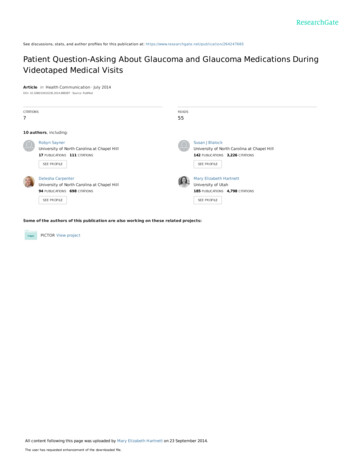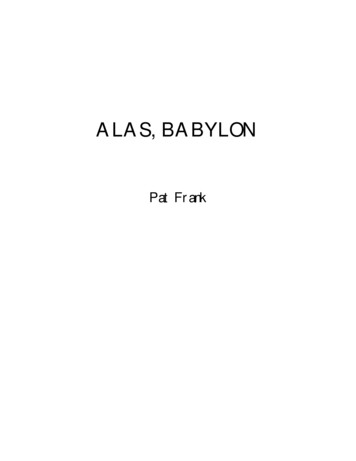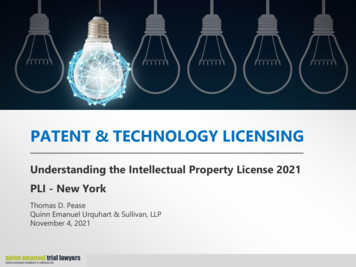
Transcription
See discussions, stats, and author profiles for this publication at: Patient Question-Asking About Glaucoma and Glaucoma Medications DuringVideotaped Medical VisitsArticle in Health Communication · July 2014DOI: 10.1080/10410236.2014.888387 · Source: PubMedCITATIONSREADS75510 authors, including:Robyn SaynerSusan J BlalockUniversity of North Carolina at Chapel HillUniversity of North Carolina at Chapel Hill17 PUBLICATIONS 111 CITATIONS142 PUBLICATIONS 3,226 CITATIONSSEE PROFILESEE PROFILEDelesha CarpenterMary Elizabeth HartnettUniversity of North Carolina at Chapel HillUniversity of Utah94 PUBLICATIONS 698 CITATIONS185 PUBLICATIONS 4,798 CITATIONSSEE PROFILESEE PROFILESome of the authors of this publication are also working on these related projects:PICTOR View projectAll content following this page was uploaded by Mary Elizabeth Hartnett on 23 September 2014.The user has requested enhancement of the downloaded file.
This article was downloaded by: [University of Utah]On: 23 September 2014, At: 13:34Publisher: RoutledgeInforma Ltd Registered in England and Wales Registered Number: 1072954 Registered office: Mortimer House,37-41 Mortimer Street, London W1T 3JH, UKHealth CommunicationPublication details, including instructions for authors and subscription atient Question-Asking About Glaucoma and GlaucomaMedications During Videotaped Medical VisitsabaaacBetsy Sleath , Robyn Sayner , Susan J. Blalock , Delesha M. Carpenter , Kelly W. Muir , MarydefghiE. Hartnett , Gail Tudor , Scott Lawrence , Annette L. Giangiacomo & Alan L. RobinaDivision of Pharmaceutical Outcomes and Policy, University of North Carolina EshelmanSchool of PharmacybCecil G. Sheps Center for Health Services Research, University of North Carolina at ChapelHillcDepartment of Ophthalmology, School of Medicine, Duke University and Durham VA MedicalCenterdDepartment of Ophthalmology and Visual Sciences, University of UtaheDepartment of Science and Mathematics, Husson UniversityfUniversity of North Carolina Kittner Eye CentergDepartment of Ophthalmology, University of North Carolina at Chapel HillhDepartment of Ophthalmology, Emory University School of MedicineiDepartment of International Health, Bloomberg School of Public Health and Department ofOphthalmology, Johns Hopkins University School of MedicinePublished online: 25 Jul 2014.To cite this article: Betsy Sleath, Robyn Sayner, Susan J. Blalock, Delesha M. Carpenter, Kelly W. Muir, Mary E. Hartnett,Gail Tudor, Scott Lawrence, Annette L. Giangiacomo & Alan L. Robin (2014): Patient Question-Asking About Glaucoma andGlaucoma Medications During Videotaped Medical Visits, Health Communication, DOI: 10.1080/10410236.2014.888387To link to this article: SE SCROLL DOWN FOR ARTICLETaylor & Francis makes every effort to ensure the accuracy of all the information (the “Content”) containedin the publications on our platform. However, Taylor & Francis, our agents, and our licensors make norepresentations or warranties whatsoever as to the accuracy, completeness, or suitability for any purpose of theContent. Any opinions and views expressed in this publication are the opinions and views of the authors, andare not the views of or endorsed by Taylor & Francis. The accuracy of the Content should not be relied upon andshould be independently verified with primary sources of information. Taylor and Francis shall not be liable forany losses, actions, claims, proceedings, demands, costs, expenses, damages, and other liabilities whatsoeveror howsoever caused arising directly or indirectly in connection with, in relation to or arising out of the use ofthe Content.This article may be used for research, teaching, and private study purposes. Any substantial or systematicreproduction, redistribution, reselling, loan, sub-licensing, systematic supply, or distribution in anyform to anyone is expressly forbidden. Terms & Conditions of access and use can be found at ns
Health Communication, 00: 1–9, 2014Copyright Taylor & Francis Group, LLCISSN: 1041-0236 print / 1532-7027 onlineDOI: 10.1080/10410236.2014.888387Patient Question-Asking About Glaucoma and GlaucomaMedications During Videotaped Medical VisitsBetsy SleathDownloaded by [University of Utah] at 13:34 23 September 2014Division of Pharmaceutical Outcomes and PolicyUniversity of North Carolina Eshelman School of Pharmacy andCecil G. Sheps Center for Health Services ResearchUniversity of North Carolina at Chapel HillRobyn Sayner, Susan J. Blalock, and Delesha M. CarpenterDivision of Pharmaceutical Outcomes and PolicyUniversity of North Carolina Eshelman School of PharmacyKelly W. MuirDepartment of Ophthalmology, School of MedicineDuke University andDurham VA Medical CenterMary E. HartnettDepartment of Ophthalmology and Visual SciencesUniversity of UtahGail TudorDepartment of Science and MathematicsHusson UniversityScott LawrenceUniversity of North Carolina Kittner Eye Center andDepartment of OphthalmologyUniversity of North Carolina at Chapel HillAnnette L. GiangiacomoDepartment of OphthalmologyEmory University School of MedicineAlan L. RobinDepartment of International HealthBloomberg School of Public Health andDepartment of OphthalmologyJohns Hopkins University School of MedicineCorrespondence should be addressed to Betsy Sleath, Division of Pharmaceutical Outcomes and Policy, University of North Carolina Eshelman School ofPharmacy, 2212 Kerr Hall CB # 7573, Chapel Hill, NC 27599-7573. E-mail: betsy sleath@unc.edu
2SLEATH ET AL.Downloaded by [University of Utah] at 13:34 23 September 2014We applied the ecologic model of communication in medical consultations to examine howpatient, physician, and situational/contextual factors are associated with whether patients askone or more questions about glaucoma and glaucoma medications during visits to ophthalmologists. Patients with glaucoma who were newly prescribed or already on glaucoma medicationswere recruited at six ophthalmology clinics. Patients’ visits with their doctors were videorecorded and patients were interviewed after visits. Generalized estimating equations wereused to analyze the data. Two hundred and seventy-nine patients participated. Patients askedone or more questions about glaucoma during 59% of visits and about glaucoma medicationsduring 48% of visits. Patients who were newly prescribed glaucoma medications were significantly more likely to ask one or more questions about glaucoma and glaucoma medications.Whether providers asked patients if they had questions was not significantly associated withpatient question-asking. Patients were significantly more likely to ask older providers questions about glaucoma medications and female providers questions about glaucoma. Eye careproviders should encourage glaucoma patients to ask questions during their medical visits.Between 9 and 12% of all blindness in the United Statesis attributed to glaucoma (Glaucoma Research Foundation,2010). The absence of symptoms in glaucoma patientsincreases the risk of regimen nonadherence among thesepatients. Approximately 50% of individuals who start onglaucoma medications discontinue them within 6 months(Nordstrom, Friedman, Mozaffari, Quigley, & Walker, 2005;Schwartz, Platt, Reardon, & Mychaskiw, 2007). Also,research has shown that continued users of glaucoma medications are nonadherent (Friedman et al., 2009; Muir et al.,2006; Sleath et al., 2006; Sleath, Blalock, Stone, et al., 2012).Further, even when patients attempt to adhere to theireye drop medications, research has shown that patient performance during eye drop administration is poor (Sleath,Blalock, Stone, et al., 2012; Stone, Robin, Novack, Covert,& Cagle, 2009). In a recent study where 140 experiencedglaucoma patients were videotaped while instilling their eyedrops, 18% of patients missed their eye when administering their drops, only 60% of patients correctly instilled thecorrect number of drops, and 65% of patients contaminatedthe bottle by touching it to the eye (Stone et al., 2008).Research has also shown that 60% or more of glaucomapatients express problems in using their glaucoma medications as prescribed (Sleath et al., 2006; Sleath et al., 2009;Sleath, Blalock, Covert, et al., 2012), including, paying forthe medication, difficulty getting the drops in the eyes, reading the print on the bottle, and remembering to take themedication (Sleath et al., 2006; Sleath et al., 2009; Sleath,Blalock, Covert, et al., 2012).This suggests that many patients might have reasons toask their ophthalmologists questions about their glaucomaand how to correctly use prescribed glaucoma medications,yet little is known about ophthalmologist–patient communication during glaucoma visits. Two qualitative studies foundthat glaucoma patients reported poor communication withtheir providers as negatively impacting adherence (Tayloret al., 2002; Tsai et al., 2003). Unfortunately, these studies did not investigate actual communication (Taylor et al.,2002; Tsai et al., 2003). Another prior study found thatpatients who reported being less likely to ask their eye doctorquestions during visits also reported being less adherent totheir glaucoma medications (Stryker et al., 2010). One priorstudy that did examine ophthalmologist and patient communication during 51 videotaped glaucoma visits found thatpatients asked questions about the following topics mostoften during visits: intraocular pressure (20%), details aboutthe medication regimen (20%), and disease status (14%)(Friedman et al., 2009). However, the study did not describethe types of questions asked in any detail, nor did it tryto examine what factors predicted patient question-asking(Friedman et al., 2009).Patient question-asking is important because it is a formof active patient participation during medical visits wherepatients can ask for more information (Cegala, Street, &Clinch, 2007; Street, Gordon, Ward, Krupat, & Kravitz,2005). Patient question-asking can potentially improvepatient self-efficacy in managing glaucoma, because ifpatients ask questions about how to correctly use eye dropsor resolve problems in using glaucoma medications, they canreceive information from the doctor and gain more confidence in managing their glaucoma (Sleath et al., 2010; Sleathet al., 2011; Sleath, Blalock, Covert, et al., 2012).Patient activation has been found to increase patient satisfaction, perceived health, and adherence; decrease anxietylevels; and improve diabetes and hypertension management (Greenfield, Kaplan, Ware, Yano, & Frank, 1988;Harrington, Noble, & Newman, 2004; Katz, Jacobson,Veledar, & Kripalani 2007; Venetis, 2013).The theoretical rationale for this study is the ecologicmodel of communication in medical consultations (Street,2003; Street et al., 2005). This model hypothesizes that theway patients communicate with physicians is influenced bypersonal, physician, and contextual factors (Street, 2003;Street et al., 2005). Personal factors could be the patient’sgender, race, age, health literacy (Street et al., 2005); physician factors could be age, gender, race; and contextual orsituational factors could be if the physician asks the patientwhether they have questions during the visit or it could bewhether the visit is a follow-up or initial visit (Street, 2003;Street et al., 2005).
Downloaded by [University of Utah] at 13:34 23 September 2014PATIENT QUESTION-ASKING ABOUT GLAUCOMAEmpirical research has provided support for Street’smodel by documenting that personal, physician, and contextual factors all affect patient–provider communication.Regarding personal characteristics, non-White, workingclass, less educated, and low-literacy patients are all lesslikely to participate in the medical visit (Brody, 1989;Davis et al., 1993; Eggly et al., 2011; Street, Voigt, Geyer,Manning, & Swanson, 1995; Street et al., 2005; Waitzkin,1985).Studies have found contradictory results in terms ofhow patient age impacts question-asking (Kidd, Marteau,Robinson, Ukoumunne, & Tydeman, 2004; Maly, Umezawa,Leake, & Silliman, 2004; Sleath, Roter, Chewning, &Svarstad, 1999; Sleath, Rubin, & Huston, 2003; Street et al.,1995).Regarding physician factors, patients seeing olderphysicians are significantly more likely to ask a questionduring medical visits (Aboumatar, Carson, Beach, Roter, &Cooper, 2013; Sleath et al., 1999; Sleath, Rubin, Campbell,Gwyther, & Clark, 2001; Sleath et al., 2003). In terms of situational factors, patients started on new medications are morelikely to ask questions during medical visits (Sleath et al.,1999; Sleath et al., 2003).Therefore, the purpose of this study was to apply theecologic model of communication in medical consultations(Street, 2003; Street et al., 2005) to examine how patient(age, gender, race, literacy, years of education), physician(age, gender, race), and situational (whether the physicianasks the patient if they have questions during the visit,whether glaucoma medications are prescribed for the firsttime) factors are associated with whether patients ask one ormore questions about glaucoma and one or more questionsabout glaucoma medications.METHODSProcedureEnglish-speaking adult glaucoma patients were enrolledbetween 2009 and 2012 at six geographically distinctophthalmology clinics located in four states. Two siteswere private offices and four were affiliated with academic ophthalmology departments. At each site, clinic staffreferred eligible patients to research assistants who werebased at the clinics. Written patient and provider consent wasobtained. Providers completed a short demographic questionnaire after providing consent. The patient’s medical visitwas video-taped. Videotapes were kept if they fit into one oftwo criteria: (a) the patient was diagnosed with glaucoma andglaucoma medications were prescribed for the first time or(b) patients were already on glaucoma medications. Patientswere interviewed after their medical visits. The study wasapproved by the University of North Carolina InstitutionalReview Board and was Health Insurance Portability andAccountability Act (HIPAA) compliant.3MeasurementSociodemographic characteristics. Patient age, race,gender, years of education, and whether the patient wasprescribed a glaucoma medication for the first time wereassessed. Additionally, each subject completed the RapidEstimate of Adult Literacy in Medicine (REALM). This isa validated, rapid screening instrument designed to identifypatients who have difficulty reading common medical andlay terms that are routinely used in patient education materials (Davis et al., 1993). We choose the REALM because ithas high face validity and high criterion validity, it has beenwell received by patients, and it only takes 2 to 3 minutes toadminister and score (Davis et al., 1993). Patient scores onthe REALM correspond to reading levels (score of 0–60 eighth grade and below, 61–66 ninth grade and above).Physician age, gender, and race were measured.Communication measures. All of the medical visitvideotapes were transcribed verbatim. A detailed transcriptcoding tool was developed over a 1-year period for thestudy using input from the communication experts andophthalmologists on the study team. Using a detailed coding tool and coding rules for the transcribed medicalvisits, three research assistants (who were not the sameresearch assistants who recruited the patients at the clinics)recorded whether patients asked one or more questions aboutglaucoma medications and whether they asked one or morequestions about glaucoma. The coders also wrote down allof the actual questions that patients asked. The coders alsonoted whether the doctor asked whether the patient had anyquestions.The glaucoma and glaucoma medication question-askingcoding categories were developed using the patient questionasking literature (Kidd et al., 2004; Maly et al., 2004; Sleathet al., 1999; Sleath et al., 2003; Street et al., 1995) andinput received from the ophthlamologists on the study team.After the original categories were developed and defined, thepatient questions were reviewed and the categories were further refined with input from the principal investigator andthe research team. The questions were then classified intothe categories described in Table 1.Patient questions about glaucoma medications were classified into five main areas: (a) information about glaucomamedications, including the name, strength, and side effectsof the medication; (b) information about the medicationregimen, such as dose, which eye(s) to instill the medication in, and frequency of use; (c) how to administer themedication, which includes questions about how to instilleye drops and about how long to wait between instillingtwo different eye drops; (d) cost or supply of the medication; and (e) information about the purpose or importanceof using glaucoma medications and adherence strategies.If a question was asked that did not fit into these five categories, it was classified as an “other question about glaucomamedications.”
4SLEATH ET AL.TABLE 1Description of the Types of Patient Questions About Glaucoma Medications and GlaucomaGlaucoma Medication Question CategoryHow to administer the glaucoma medicationMedication regimenCost or supplyMore detailed information about glaucoma medicationsDownloaded by [University of Utah] at 13:34 23 September 2014Adherence strategies, purpose of using, and the importance of usingglaucoma medicationsOtherGlaucoma Question CategoryMore detailed information about glaucomaTreatment of glaucoma, excluding questions about medicationsIntraocular pressure (IOP)OtherSimilarly, questions asked by patients about glaucomawere classified into three main areas: (a) information aboutthe disease, including diagnosis and prognosis; (b) treatmentoptions for glaucoma, such as whether to treat or to watchand wait, information about surgery versus medications, andthe duration of glaucoma treatment; and (c) informationabout intraocular pressure (IOP), including the definition ofit as well as what was the current IOP reading. If a patientquestion did not fit into the three main categories, it wascategorized as an “other question about glaucoma.”The three research assistants coded 25 of the same transcripts throughout the study period. After the coders weretrained using the coding rules and sheets, they met monthlyto discuss discrepancies in coding to prevent coder decay.Intercoder reliability was calculated using Cohen’s kappa.Cohen’s kappa was 0.78 for whether the patient asked aquestion about glaucoma medications, 0.84 for whetherthe patient asked one or more questions about glaucoma,and 1.0 for whether the doctor asked if the patient had anyquestions.AnalysisWe set the a priori level of statistical significance to p .05. First, we presented descriptive statistics. Second, weexamined the bivariate relationships among the independentDescriptionIncludes questions about the amount of time to wait between administeringtwo eye medications and about the nasolacrimal occlusionIncludes questions about the dose, frequency, which eye in which to instill theeye drop, whether to continue the current medication regimen, and thepossibility of long-term use of glaucoma medicationsIncludes various topics such as the cost of the medication, genericformulations, the need for refills, and how long a bottle of medicationshould last before needing a refillIncludes questions such as the about the possible side effects of themedication and about the name of the medicationIncludes topics such as why glaucoma medications were prescribed and howto remember to take the medications consistentlyIncludes various unusual topics such as patient concerns or barriers with usingglaucoma medication, how well the glaucoma medication was working,and the use of nonglaucoma medicationsDescriptionIncludes
Center d Department of Ophthalmology and Visual Sciences, University of Utah e Department of Science and Mathematics, Husson University f University of North Carolina Kittner Eye Center g Department of Ophthalmology, University of North Carolina at Chapel Hill h Department of Ophthalmology, .











